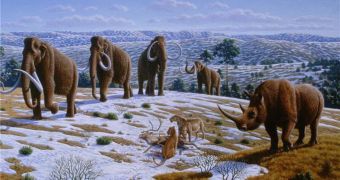According to a new set of scientific observations, it would appear that big, prehistoric mammals lived in the Iberian Peninsula more than 150,000 years ago.
The new data shows that, even if in small numbers, these beasts roamed the landscape in what is now Portugal and Spain. The species include woolly mammoths, woolly rhinoceroses and reindeers.
The new study was conducted by a team made up of experts from the University of Oviedo (UO) and the Complutense University of Madrid (UCM), in Spain.
They say that all these large species can in fact be considered indicators of cold climates, given that these were the only conditions in which they enjoyed living.
This new finding therefore casts new light on the landscape of the Iberian Peninsula all those millennia ago. Researchers now believe that the area may have in fact been subjected to much lower temperatures than originally thought.
Experts pooled together existing datasets on all prehistoric species even discovered in the area, AlphaGalileo reports.
They looked at the woolly mammoth (Mammuthus primigenius), the woolly rhinoceros (Coelodonta antiquitatis), the reindeer (Rangifer tarandus), the wolverine (Gulo gulo), the arctic fox (Alopex lagopus), the musk-ox (Ovibos moschatus) and the Saiga antelope (Saiga tatarica).
“The findings of cold climate fauna in the Iberian Peninsula coincide with the periods of greatest global cooling recorded in the ice of Greenland” scientist Diego Alvarez-Lao says for SINC.
He is the main author of the new study, and also a researcher at the UP Palaeontology Department. The expert says that the findings are in agreement with isotopic composition readings collected from samples taken from Greenland ices.
“The environmental conditions in central and northern Europe were so extreme that the animals were obliged to migrate to the south, where the climate was less severe,” Alvarez-Lao explains of why the creatures moved this far away.
It would appear that some of these animals shared the land with early humans, as well as with some of our ancestors. There is clear evidence that Neanderthals lived in the area when mammoths did.
“These species lived alongside different human cultures. There is evidence in some sites of the Basque country, Navarra and Catalonia that the Neanderthals coexisted with the mammoths and the reindeer at specific times,” the main author of the work says.
“However, the majority of evidence of these faunae coincides with the periods of the Gravettian, Solutrean and Magdalenian cultures (during the Upper Paleolithic era in West Europe),” Alvarez-Lao concludes.

 14 DAY TRIAL //
14 DAY TRIAL //